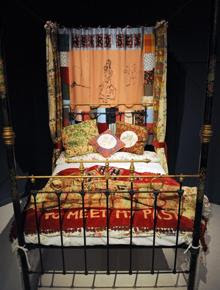
An installation by artist Tracey Emin at the V&A;
For me quilts represent memory and history, of people, places, situations and relationships. The epic length of time that it takes to create a quilt gives the object its own history of its making and its own story. When I left for University, 4 years ago my mother vowed to start on a quilt for me… I think she managed about 6 squares, and that took her long enough. I still live in hope that she will complete it, one day!
The current exhibition at the V&A; explores over 300 years of British quilting history – and includes private loans as well as many from the V&A;’s own collection. The show is vast and the variety on display is impressive, although I was slightly disappointed that the works were exclusively British, as there are, in particular, many wonderful American quilts. The older quilts, bed-hangings, and cushions seem to be preserved and restored immaculately, and show the luxury and wealth associated with this trade in the 18th Century. I particularly loved the quilts that celebrated the birth of a child, often white and tiny to fit the newborn babe, with the sweetest words sewn on as messages, they evoked a real poignancy.
The more contemporary pieces show the trends and fashions of today. A fantastic outrageous Union Jack quilt made from various Libertys floral prints was eye-catching to say the least. Influential artists, Grayson Perry and Tracey Emin’s works reflect their own bedtime preoccupations and attitude to the culture of the quilt. The exhibition illustrates the power of the quilt and why it has remained so popular for many hundreds of years.
Quiltmaking is an activity that those in dreadful situations can turn to. There is a video showing the inmates of Wandsworth Prison and their quest to produce a quilt. It offers them a skill and gives them a quiet way to consider their situation and vent their frustration. The outcome is quite beautiful and moving as you see these men turn their anger to a creative, constructive focus – thoughts of freedom and despair weave through the carefully made artwork. Once again the gentle power of the quilt is evident.
Quilts 1700-2010 is on display until 4 July 2010 at the V&A;:
http://www.vam.ac.uk/exhibitions/future_exhibs/Quilts/index.html
Learn how to make a patchwork quilt yourself here: http://www.ehow.com/how_2071698_make-patchwork-quilt.html